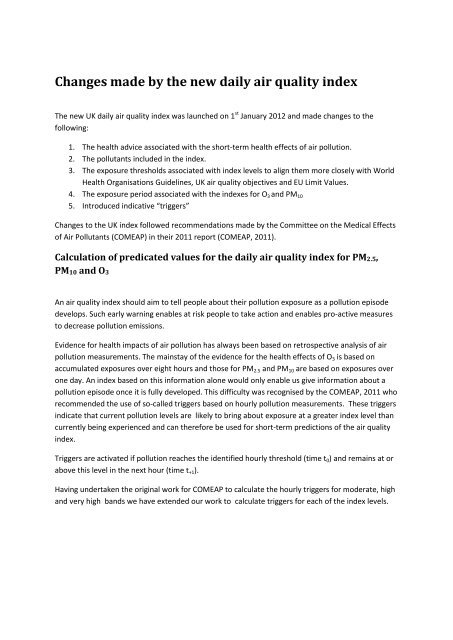1st January 2012 onwards - London Air Quality Network
1st January 2012 onwards - London Air Quality Network
1st January 2012 onwards - London Air Quality Network
Create successful ePaper yourself
Turn your PDF publications into a flip-book with our unique Google optimized e-Paper software.
Changes made by the new daily air quality index<br />
The new UK daily air quality index was launched on 1 st <strong>January</strong> <strong>2012</strong> and made changes to the<br />
following:<br />
1. The health advice associated with the short-term health effects of air pollution.<br />
2. The pollutants included in the index.<br />
3. The exposure thresholds associated with index levels to align them more closely with World<br />
Health Organisations Guidelines, UK air quality objectives and EU Limit Values.<br />
4. The exposure period associated with the indexes for O 3 and PM 10<br />
5. Introduced indicative “triggers”<br />
Changes to the UK index followed recommendations made by the Committee on the Medical Effects<br />
of <strong>Air</strong> Pollutants (COMEAP) in their 2011 report (COMEAP, 2011).<br />
Calculation of predicated values for the daily air quality index for PM2.5,<br />
PM10 and O3<br />
An air quality index should aim to tell people about their pollution exposure as a pollution episode<br />
develops. Such early warning enables at risk people to take action and enables pro-active measures<br />
to decrease pollution emissions.<br />
Evidence for health impacts of air pollution has always been based on retrospective analysis of air<br />
pollution measurements. The mainstay of the evidence for the health effects of O 3 is based on<br />
accumulated exposures over eight hours and those for PM 2.5 and PM 10 are based on exposures over<br />
one day. An index based on this information alone would only enable us give information about a<br />
pollution episode once it is fully developed. This difficulty was recognised by the COMEAP, 2011 who<br />
recommended the use of so-called triggers based on hourly pollution measurements. These triggers<br />
indicate that current pollution levels are likely to bring about exposure at a greater index level than<br />
currently being experienced and can therefore be used for short-term predictions of the air quality<br />
index.<br />
Triggers are activated if pollution reaches the identified hourly threshold (time t 0 ) and remains at or<br />
above this level in the next hour (time t +1 ).<br />
Having undertaken the original work for COMEAP to calculate the hourly triggers for moderate, high<br />
and very high bands we have extended our work to calculate triggers for each of the index levels.
Index reporting<br />
O 3<br />
The new index for O 3 is based on exposure over a rolling 8 hours rather than the mixture of hourly<br />
and rolling 8 hour exposure used prior to <strong>2012</strong>. The thresholds for indices 5-10 have been lowered.<br />
The index based on the measured 8 hour rolling average is reported unless an hourly based “trigger”<br />
has been activated for a greater index level, in which case this is reported.<br />
The following precedence for real time reporting is applied:<br />
a. An index based on a measured 8 hour rolling average<br />
b. A predicted higher index based on an activated “trigger” if this is greater than a). “Triggers”<br />
for O 3 remain active for the next 5 hours (t +1 to t +5 ).<br />
It should be noted that the 8 hour rolling exposure is the definitive measurement of air quality and<br />
takes precedence over the “trigger” results for retrospective analysis, the “triggers” are only<br />
indicative for advance warnings.<br />
PM 10 and PM 2.5<br />
The index for PM 10 is now based on a fixed midnight to midnight exposure period rather than the<br />
previous rolling 24 hour exposure. This means that there is a break point at the start of each day so<br />
that the previous evening’s measurements have no impact on the new day’s index. The thresholds<br />
for all indices have been lowered. The same criteria have been applied to the indexing of the newly<br />
added PM 2.5. The PM 10 measurements must also be EU reference equivalent.<br />
Once activated the PM 10 and PM 2.5 triggers remain active for the rest of that day, i.e the reporting<br />
period.<br />
The near real time reporting of indices for PM 10 and PM 2.5 , is particularly challenging because the<br />
measured index is not available until the end of the day (or until a representative 75% data capture<br />
has been achieved for the day). This leaves un-reportable the situation where insufficient data is<br />
available to report the daily average and no triggers have activated. Sticking with COMEAP’s desire<br />
to move away from the previously used rolling 24 hour rolling average we have therefore devised<br />
the following reporting regime for those hours not covered by COMEAP’s index definition (as<br />
accepted by Defra) or our extended triggering:<br />
Initially it is assumed that each new day will be an average day based on the mean pollution<br />
concentration during the previous year. As measurements are made these average hours are<br />
replaced by actual measurements, making adjustments from the average day.<br />
e.g if the annual average PM 10 or PM 2.5 for a site is X then we start by assuming that the new day<br />
will be an average of 24 hours at the annual mean concentration i.e<br />
X 1 , X 2 , X 3 , X 4 , X 5 , X 6 , X 7 ………X 24 Predicted daily mean
As we collect data each average hour X t ….etc, is replaced with actual measurements so after three<br />
hours with readings A, B, C the predicted daily mean concentration will be:<br />
A, B, C, X 4 , X 5 , X 6 , X 7 ………X 24<br />
In scientific notation<br />
If the annual average PM 10 or PM 2.5 for a site is Y then we start by assuming that the new day will be<br />
an average of 24 hours at the annual mean concentration i.e<br />
Predicted daily mean<br />
Where Xt = Y<br />
As we collect data each average hour X t ….etc, is replaced with actual measurements so after three<br />
hours with readings A, B, C the predicted daily mean concentration will be:<br />
Predicted daily mean<br />
So the predicted new day is assumed to be average until we know differently and is constantly<br />
adjusted as we know more, reacting to the most recent measured pollution.<br />
As with the index itself these calculations are based only on reference equivalent concentrations for<br />
PM 10 .<br />
The following precedence for real time reporting is applied:<br />
a. The index based on predicted daily average as detailed above if data based on b) or c) is not<br />
available.<br />
b. A predicted index based on an hourly trigger being activated.<br />
c. The index based on a representative daily mean if this is greater than a) or b)<br />
d. Final index when all data for the day has been collected<br />
It should be noted that the measured full day exposure d) is the definitive measurement of air<br />
quality and takes precedence over a), b) and c) for retrospective analysis; these are only indicative<br />
for advance warnings.<br />
CO<br />
This was dropped from the index due to the dramatic reduction in outdoor concentrations. CO<br />
remains an important hazard for indoor air pollution.<br />
SO2<br />
No change.<br />
NO2<br />
Threshold levels for all indexes were reduced to match WHO Guidelines, the EU hourly mean limit<br />
and the UK air quality strategy objective.
Timothy Baker, Gary Fuller, Andrew Grieve and Robert Hepburn, King’s College <strong>London</strong> – <strong>January</strong><br />
<strong>2012</strong>.



